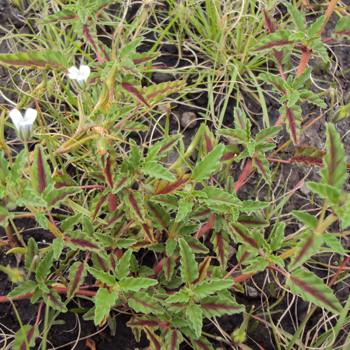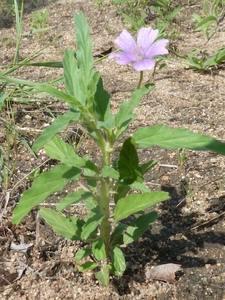Monsonia angustifolia
Monsonia angustifolia Sond.
Family: Geraniaceae
Common names: Crane's bill; alsbos, angelbossie, teebossie (Afr.), malengoana (Southern Sotho), Tee ya thaba (Sepedi)
Introduction
Monsonia angustifolia is an annual herb with wavy leaves found in open grasslands and often along roadsides throughout South Africa and tropical Africa.

Description
Description
Monsonia angustifolia is an annual herb that grows up to 0.5 m, although usually shorter. Stems are slightly woody at the base, pubescent and covered with very short gland-tipped hairs among the longer stems. Leaves are narrowly oblong or elliptic. Margins are irregularly toothed with cuneate bases. Flowers are mauve to blue, or rarely white or yellowish. Fruit are held erect, 50-90 mm long.

Conservation Status
Status
Monsonia angustifolia is Red Listed as Least Concern.
Distribution and habitat
Distribution description
M. angustifolia is widely distributed in the southern African region where it is found in South Africa, Lesotho, Swaziland, Namibia and Mozambique. It usually occurs on granite, often on rocky areas and along the side of roads.
Derivation of name and historical aspects
History
The genus Monsonia was named after Lady Anne Monson, a botanist and collector of plants and insects. The specific epithet, angustifolia, is Latin meaning narrow-leaved.
Ecology
Ecology
Monsonia angustifolia seeds are dispersed by wind and water during rain. Flower colours attract insects and bees for pollination.

Uses
Use
M. angustifolia is a traditional herb used for the treatment of erectile dysfunction and for the enhancement of libido. Further information from traditional practitioners indicate that it is used as a sexual stimulant and blood cleanser. It is speculated that it is the plant known as 'Special' used by some religious group members as a blood cleanser. Teebossie is also used to treat medical conditions such as heartburn, anthrax, diarrhoea etc.
Growing Monsonia angustifolia
Grow
Monsonia angustifolia grows easily from seed. It is not commonly cultivated as a horticultural plant.
References
- Bailey, L.H. & Bailey, E.Z. 1976. Hortus third , edn 1: 3. Macmillan, New York.
- Bruneton, J. 1999. Toxic plants: dangerous to human and animals . Lavoisier Publishing, France.
- Dreisbach, R.H. 1971. Handbook of poisoning . Lange Medical Publications, Los Altos.
- Hardin, J.W. & Arena, J.M. 1974. Human poisoning from native and cultivated plants . Duke University Press, Durham.
- Hutchings, A., Scott, A.H., Lewis, G. & Cunningham, A. 1996. Zulu medicinal plants : an inventory. University of Natal Press, Pietermaritzburg.
- Moll, E., Moll, G. & Strebel, R.C. 1989. Poisonous Plants . Struik, Cape Town.
- Palmer, E. 1985. The South African Herbal . Tafelberg, Cape Town.
- Roberts, M. 1990. Indigenous healing plants . Southern Book Publishers, Halfway House.
- Watt, J.M. & Breyer-Brandwijk, M.G. 1962. The medicinal and poisonous plants of Southern and Eastern Africa , 2nd ed. E. &S. Livingstone, Ltd, London.
Credits
Thabo Masupa
National Herbarium, Pretoria
January 2014
Plant Attributes:
Plant Type: Bi/Annual
SA Distribution: Eastern Cape, Free State, Gauteng, KwaZulu-Natal, Limpopo, Mpumalanga, North West, Northern Cape, Western Cape
Soil type: Loam
Flowering season: Spring, Early Summer
PH: Neutral
Flower colour: Blue, Mauve/Lilac
Aspect: Full Sun
Gardening skill: Average
Special Features:
Horticultural zones









Rate this article
Article well written and informative
Rate this plant
Is this an interesting plant?
Login to add your Comment
Back to topNot registered yet? Click here to register.